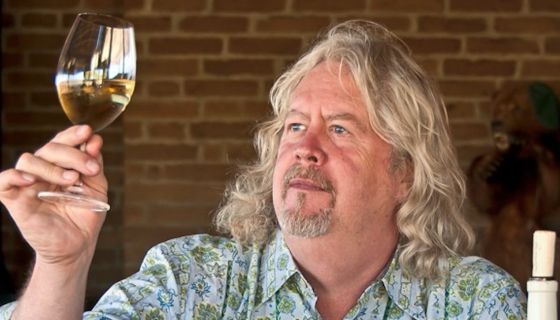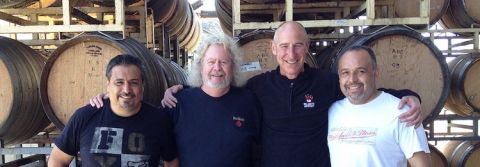There is news that will send shockwaves throughout the wine world. Jim Clendenen, ‘the mind behind’ Au Bon Climat in Santa Barbara County as he took to describing himself, died in his sleep on Saturday night. He was only 68 but, after a truly hectic life of drinking, making, promoting and thinking about wine, he had become increasingly aware of his age. In an excellent hour-long Wine Institute webinar hosted last August by our Elaine Chukan Brown, he lamented the restrictions imposed on his life by the pandemic. This quintessentially sociable, hugely distinctive wine producer observed ruefully, ‘it’s a nightmare to be spending the last years of your life trapped in your own home in your own company. In a schizophrenic sense I wish I were a better person.’
His many friends around the world had doubtless increasingly urged him to ‘take care of yourself’ (his father had suffered heart problems) but that was not in the noisy spirit of Jim Clendenen, whom I christened Wild Boy decades ago. With his long blonde curls and loud shirts he was a party animal, a rabble-rouser, yet the wines he made, with admirable consistency, even throughout the 1990s when California fell in love with heft, were the exact opposite of exhibitionist. Au Bon Climat’s Chardonnays and Pinots Noirs are models of long-lived restraint. Clendenen built a 5,000 square foot, 35 foot high ‘library’ in which to house his older vintages and, when the Masters of Wine stopped off at Au Bon Climat in the Santa Maria Valley in 2018, he was proud of being able to cook lunch and serve a 20-year-old Chardonnay to the 50-plus members of the group. ‘Not too many other people in California could do that.’
It was his time in Burgundy that inspired him to keep back a library of older vintages, and indeed inspired the creation and entire ethos of Au Bon Climat. He first visited Burgundy in 1977 and first participated in a vintage in 1981 which chiefly entailed waiting for the grapes to ripen. During the wait he was lucky enough to accompany top-notch cooper Jean François of François Frères on his rounds. This meant he was not only privy to the secrets of oak selection and seasoning but was also exposed to the greatest names and techniques in the Burgundy firmament (though Clendenen was presumably more likely to remember Aubert de Villaine than vice versa).
He also apparently also did a stint in Australia around this time but neither wine writer James Halliday nor Michael Hill Smith of Shaw + Smith can remember him as a cellar rat – though they certainly admired him as a winemaker. A flavour of Clendenen’s style is the story he told Elaine about his relative experiences: ‘In California they tell you how to turn a pump on. In Australia they show you how to build a pump. In Burgundy they tell you you don’t need a pump.’
Au Bon Climat was born in 1982, originally in an old dairy in Los Alamos and subsequently in a shed on the northern fringes of Bien Nacido vineyard in the Central Coast when all the focus of California wine was on Napa and Sonoma. Adam Tolmach, with whom Clendenen had worked at Zaca Mesa to the south in Los Olivos, was Clendenen’s partner until concentrating on his Ojai Vineyard from 1991 when Jim bought him out. Santa Maria Valley was chosen for its reliable exposure to Pacific influence, much lower temperatures than Napa and Sonoma, and long growing season.
Always informed by Burgundy and Burgundian techniques, Au Bon Climat has not changed, only refined, its style of wine over the decades, and effectively sat out the craze for ripe, deep-coloured, alcoholic wines, which was not always comfortable, especially not commercially. ‘There were a lot of critics who didn’t understand my attitude, my lack of grooming and my big fricking mouth’, observed Clendenen to Elaine, ‘so I ended up butting heads with a lot of people. We’ve been waiting 30 years to be an overnight success.’
For many years Clendenen was more celebrated outside California than within it, but he admitted there was a turnaround in the attention his wines received in the wake of Raj Parr and Jasmine Hirsch’s In Pursuit of Balance movement. Today hundreds of California producers are following in Clendenen’s footsteps.
Visits to Vinitaly with his German importer in the mid to late 1980s resulted in a range of Italian varietals, with Clendenen Family Vineyards Nebbiolo arguably the most convincing riposte to Barolo produced in North America. According to Clendenen he was at one stage producing up to 14 different varieties, which he described as ‘an asinine way to make a living’. He explained to Elaine that his three great loves are Nebbiolo, Pinot Noir and now Grenache. I would love to have been a fly on the wall when Jacques Reynaud agreed to receive him at Château Rayas in Châteauneuf-du-Pape. (The equally unkempt Didier Dagueneau, of Pouilly-Fumé fame, was not allowed in apparently.)
His other great loves of course were his children. His blend of the finest Pinots to create an expression of each vintage is named after his daughter Isabelle, who works in sales for the winery. The produce of a particularly cool, high vineyard is named after his son Knox Alexander, godson of barrel broker Mel Knox, a frequent poster on our Members’ forum and for long a supporter of Au Bon Climat. Clendenen recently visited his son, who is currently studying in Japan. He married twice, first to Sarah Chamberlin and then to Morgan Clendenen, who made Viognier under the Cold Heaven label before they divorced and she moved to North Carolina.
That giant shed of a winery has seen so much conviviality (see Au Bon Climat – lunch and more), as well as so much great wine. Bob Lindquist of Lindquist Family Wines is also based there – a steady hand. And Clendenen has been clever, lucky or charismatic enough to establish a solid, long-term team in the winery based on the work of cellarmaster Enrique Rodriguez, who has been there since 1988, Arturo Alvarez, who has notched up 22 years overseeing operations and particularly quality control, and Jim Adelman, who has kept everything ticking over efficiently while Jim roamed the world proving that ‘I have a self-indulgent side and another questioning constantly like a kid in diapers.’
The wine world really is much the poorer without this brave pioneer. Always the life and soul of any Pinot Noir celebration (will McMinnville ever be the same?), he was bright as a button, as I personally experienced in at least three different countries, but just did a bit too much – except look after himself.
Our appreciation of 114 of his wines is here.














